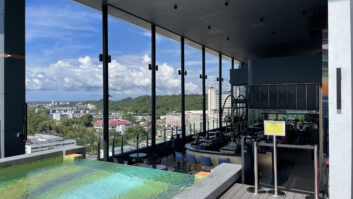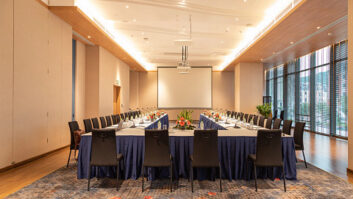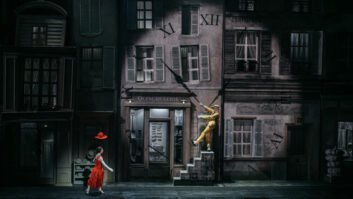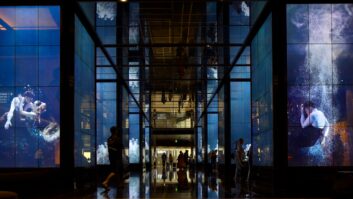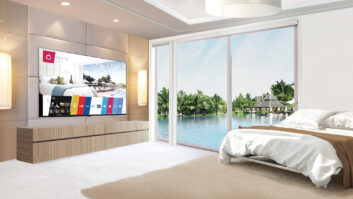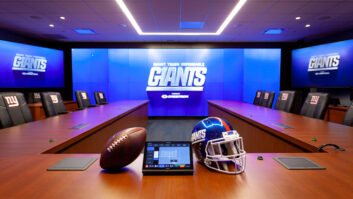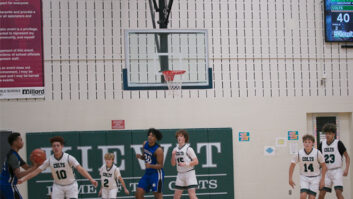The Tivoli Gardens have long been one of Copenhagen’s main tourist attractions. Walt Disney was reportedly so taken with them when he visited that he was inspired to create Disneyland, looking to replicate the gardens’ “happy and unbuttoned air of relaxed fun”. (There seems to have been some mission creep since then – Ed.)
But while the gardens have been in operation since 1843, the Tivoli Hotel – 10 minutes’ walk away – is much more recent, having opened on 10 October 2010 (10/10/10). Not surprisingly, it markets itself as the key hotel for families visiting the Gardens. However, the city only gave permission for its construction if a conference centre was included as well. Fortunately, according to Kim Johansen, the conference centre’s success far exceeded the owners’ expectations.
Johansen has had two roles in the Tivoli conference centre project: he was originally a consultant with KDNC, but later moved to integrator and reseller Danmon. Danmon was responsible for installing all the audio within the conference centre, and the hotel’s public areas (though not the guestrooms). Video and lighting equipment were installed by Atea (which has a background in IT integration) and Light Partner respectively.
The audio, video and lighting budget for this project was DKK40 million (€5.5 million), which makes it a very big Danish project, according to Johansen. In fact, he believes that for many of the audio brands featured – BSS Soundweb, Shure (wireless microphones), Turbosound and DiGiCo – the conference centre is their largest installation in Scandinavia.
The original idea, says Johansen, was to control everything from the control room in the basement – which would make the AV personnel requirement one less. This idea was abandoned, but the installed system still confers a high degree of flexibility in how, and from where, audio in particular can be controlled.
Rather than putting an ‘engine room’ on each floor of the building, it was decided to give more local control of audio. For this reason, every conference room, meeting room, lounge, and even the restaurant, has its own Soundweb unit, so that audio can be picked up and sent anywhere.
In total there are seven DiGiCo consoles on the premises: two SD7s, two SD8s and three ‘tabletop’ SD11s. Apart from the control-room SD7, these are all mobile and so can be used wherever they are required. According to Johansen, it is the best-established high-end console brand in Denmark, so visiting sound engineers are used to working with DiGiCo. In addition, the facility has four DiGiCo DiGiRacks (56 in/56 out) and four DiGiCo MaDiRacks (48/24).
Having four racks in various locations all connected has made life much easier for the AV staff at the conference centre, he explains: “Suddenly it is very easy to have a second stage in another part of the room: just use two MADI lines and put in one of the auxiliary racks the and you have access to 56 I/Os.”
Control room
The control-room audio console is at the heart of the venue’s routing requirements, explains Johansen: “We needed a console for the control room that could act as a matrix, to enable real-time routing, and mixing, to and from all locations. This adds up to a 112 x 112 matrix mixer.” The DiGiCo SD7, he says, is one of the few consoles that can supply more than 112 mix busses, and the only one at this price point.
To enable AV staff to cover several functions taking place at the same time, the control room console also had to be able to mirror the console in the Main Hall. So, for instance, staff can work in the control room while looking after a relatively straightforward audio job in the Main Hall; or change routing/mixing in the control room while working in the Main Hall.
Dual-engine consoles were selected, for redundancy. In addition, each console acts as a backup for the other.
He adds: “The control room mixer also had to be able to pick up the signals from the racks in the Main Hall and auditoriums without affecting what is going on in the selected room. This could be used to do a mix for a TV/video production, or it could be used for some of the bigger conferences, where you broadcast or stream content from various rooms to the internal TV system, so attendees can watch from other rooms or from the hotel rooms.”
The main brands of lighting fixture used in the larger rooms in the complex include ADB and Altman fresnels, ETC Source Four Zooms and Thomas PAR64 floorcans. There are no moving heads installed; these are hired in as necessary. Like the audio, lighting throughout can be fully supported from the main control room. All the complex’s lighting desks are on the same network, so if one desk breaks down, another can be used in its place. In the main congress hall, the auditoriums and the three large meeting rooms, the house lights are on a DMX network, so can be controlled on a fader from the control room. In all there are four MA Lighting grandMA2 Lite consoles around the complex.
Main Congress Hall
The Main Congress Hall, occupying an area of 2,000sqm, can seat a total of 2,500 people in the main floor area and in the balcony. (At the time of Installation’s visit, the summer holiday season is in full swing and this space has been pressed into service as a dining room.) Audio for this entire space comes from two hangs of Turbosound TFA-600 series line array speakers – there are no delay lines or ceiling speakers to augment the solution. What’s more, the variation in SPL is no more than 2dB anywhere in the room. “Sound has to come from the stage area,” comments Johansen. “I hate it when you’re sitting at the edge of a space and the sound comes at you from above.” Turbosound is an usual choice for an indoor congress space, he admits, but they are cheaper than some brands often used in such applications – “and they’re fantastic for the job”, he says.
Three screens above the stage (left, centre and right) carry images from four Barco FLM HD20 projectors – the two central ones are stacked – making a total of 80,000 lumens.
Also in the room are remote-controlled Panasonic HD cameras.
Technology in the hall is controlled from a booth behind the balcony, but thanks to stageboxes the audio and lighting consoles can be operated from the balcony or the floor. There are also a number of mobile video production trolleys. One of these, for example, contains two Panasonic camera controllers, a Panasonic HD video mixer and two TVLogic reference monitors.
The second DiGiCo SD7 console is based here. “We needed a console that can handle big events with several bands, choirs, and of course conferences: these days it is not abnormal that a conference with evening entertainment ends up with over 100 inputs with a house band and guest artists,” says Johansen.
Johansen likes the fact that the SD7 contains all the necessary functionality in a single unit, without having to add external boxes for effects, dynamics or EQ; but at the same time it is not too large to move around the venue, on a custom-built rolling tilt stand.
“When the customer does not want to see the console, you can easily do the soundcheck on the floor and then move it to the balcony for the show. When doing the show from the balcony, you can bring your laptop downstairs and control the console from there.”
Three conference rooms On the ground floor are three adjacent conference rooms, with movable partitions so that two or three rooms can be combined if necessary. Each room is fitted with a 10,000-lumen Panasonic projector and two projection screens, hidden in the ceiling and brought out when required under AMX control. There is a screen on the long and the short wall of each of the rooms, and the projector lift allows the projector to be rotated to fire onto either screen – allowing flexilibity in how the room is configured.
The equipment in each room can be controlled from the main control room in the basement. An Axis CCTV camera provides technicians with a view of what’s going on in the room, although a small screen has been put next to it, to block the view of the projected content and maintain confidentiality for clients.
In addition, each of the rooms also has its own mobile rack containing Soundweb modules, AMX controller, wireless microphone system and amplifiers. “It was decided to put equipment into each room so that each one could work on its own if there were any network issues,” explain Johansen, adding that this was a particularly useful feature when the system was originally set up. The system has been designed so that it can be operated by the user without recourse to a technician.
Auditoriums
There are two auditoriums in the basement, located alongside each other with a common control room. As in the main congress hall, Johansen designed the speaker clusters (two hangs of five Turbosound TFA600 HWDP speakers and a TFA600 subwoofer, in each room) that provide even coverage; again the SPL variation is no more than 2dB across either room.
Each auditorium is fitted with a Panasonic projector (under AMX control), but instead of using projection screens these fire directly onto the walls, which are coated in special paint. Johansen is not a great fan of this approach, though, because any damage to the surface requires the entire wall to be repainted.
The control room for the auditoriums features two ‘desktop’ DiGiCo SD11 consoles, chosen for their compact size. A MaDiRack by each of the auditorium stages provides connectivity to the SD7 in the main control room if needed.
These two rooms, as well as the Main Congress Hall, are fitted with a Clear-Com Freespeak wireless intercom, which is used by audio, video and lighting technicians.
Small meeting rooms In a similar, if cutdown, fashion to the three congress rooms, much of the AV equipment for each of the 14 small meeting rooms resides on a mobile rack tucked out of sight in a cupboard – again, under AMX control. Microphones can be wireless (Shure wireless microphone headset mics) or wired (via XLR mic/line inputs in floor boxes). A DiGiCo SD11 can be brought in if a client wishes to use more than four mics at once. Endpoints include Turbosound ceiling speakers and InFocus 6,000-lumen projectors – firing onto specially painted walls.
As befits a hotel and conference centre of this size, the Tivoli has a digital signage system to direct visitors to their desired location and provide other general information. This system, supplied by Synergis, runs across a number of displays designed and produced by manufacturer Arthur Holm, in collaboration with its Danish distributor. The most noticeable elements of the system are double-sided 42in displays in black glass. These stylish units fit well with the hotel’s contemporary interior design, and as they have been fitted with wheels they can be easily moved to any required location.
Johansen is pleased to report that the audio for the Tivoli project was delivered on time, on budget and does what was promised. In addition, the client raised no issues at a meeting held one year after the project was delivered. He remarks: “This was an interesting project to work on. It’s nice to work for people who are interested in technology, and want to do the project in a good way, not the cheapest way. I wouldn’t say this was a Mercedes installation – but maybe a very expensive Volkswagen!”
www.adblighting.com
www.altmanltg.com
www.amx.com
www.arthurholm.com
www.atea.com
www.axis.com
www.barco.com
www.bssaudio.com
www.clearcom.com
www.danmon.dk
www.digico.org
www.etcconnect.com
www.infocus.com
www.lightpartner.dk
www.malighting.com
www.panasonic.net
www.synergis-int.com
www.thomaslighting.com
www.tvlogicusa.com
www.tivolihotel.com
www.turbosound.com
